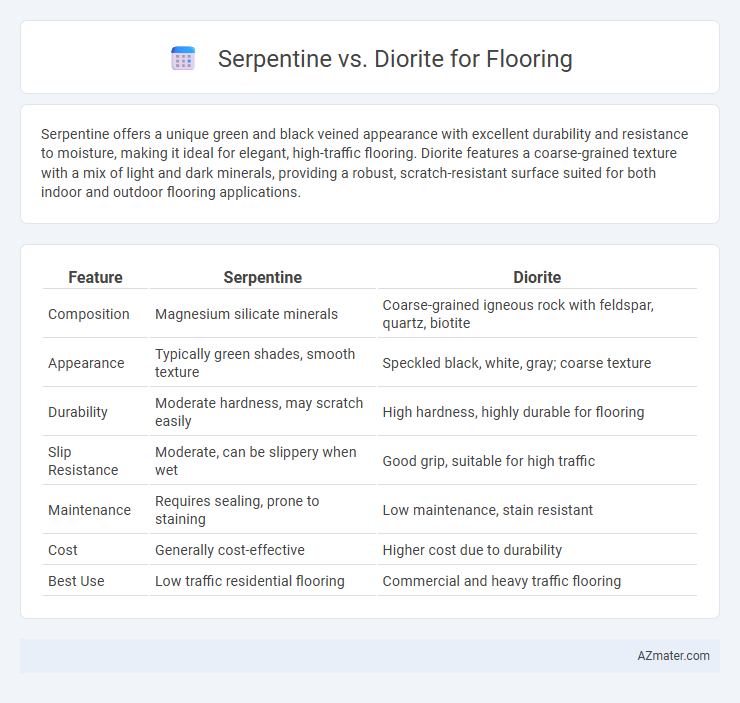Serpentine offers a unique green and black veined appearance with excellent durability and resistance to moisture, making it ideal for elegant, high-traffic flooring. Diorite features a coarse-grained texture with a mix of light and dark minerals, providing a robust, scratch-resistant surface suited for both indoor and outdoor flooring applications.
Table of Comparison
| Feature | Serpentine | Diorite |
|---|---|---|
| Composition | Magnesium silicate minerals | Coarse-grained igneous rock with feldspar, quartz, biotite |
| Appearance | Typically green shades, smooth texture | Speckled black, white, gray; coarse texture |
| Durability | Moderate hardness, may scratch easily | High hardness, highly durable for flooring |
| Slip Resistance | Moderate, can be slippery when wet | Good grip, suitable for high traffic |
| Maintenance | Requires sealing, prone to staining | Low maintenance, stain resistant |
| Cost | Generally cost-effective | Higher cost due to durability |
| Best Use | Low traffic residential flooring | Commercial and heavy traffic flooring |
Introduction to Serpentine and Diorite Flooring
Serpentine flooring is known for its rich green hues and unique veining patterns, offering durability and a naturally polished finish ideal for elegant interiors. Diorite flooring features a coarse-grained texture with a mix of black, white, and gray minerals, providing a robust and timeless surface suitable for high-traffic areas. Both stones present distinct aesthetic and functional qualities, making them popular choices in luxury flooring applications.
Geological Origins of Serpentine and Diorite
Serpentine originates from the metamorphism of ultramafic rocks, primarily composed of magnesium silicate minerals that form through hydrothermal alteration processes. Diorite, an intrusive igneous rock, crystallizes slowly beneath the Earth's surface from intermediate magma, resulting in a coarse-grained texture with a mix of plagioclase feldspar, amphibole, and biotite. These distinct geological origins influence their mineral composition, durability, and suitability for flooring applications.
Physical and Aesthetic Differences
Serpentine flooring features a smooth, often glossy surface with greenish, yellow, or brown hues that add an earthy and calming aesthetic, while Diorite presents a speckled pattern with a granular texture in shades of gray, black, and white, lending a more dramatic and sophisticated look. Physically, Serpentine is softer, with a Mohs hardness of about 3 to 5, making it more susceptible to scratches but easier to polish, whereas Diorite is harder, generally rating around 6 to 7, offering greater durability and resistance to wear in high-traffic areas. The choice between Serpentine and Diorite flooring depends on balancing the desired visual warmth and subtlety against the need for robust performance and longevity.
Durability and Strength Comparison
Serpentine offers moderate durability with a Mohs hardness of 3 to 6, making it more susceptible to scratches and wear compared to Diorite. Diorite exhibits exceptional strength and durability, with a Mohs hardness of around 6 to 7, ideal for high-traffic flooring applications due to its resistance to abrasion and impact. Choosing Diorite ensures longer-lasting flooring performance and better maintenance resistance in both residential and commercial settings.
Water and Stain Resistance
Serpentine flooring offers moderate water resistance due to its natural mineral composition but tends to absorb stains more easily compared to Diorite, which is denser and exhibits superior resistance to both water and stains. Diorite's tight grain structure minimizes porosity, making it an ideal choice for high-traffic areas prone to moisture and spills. Selecting Diorite ensures enhanced durability and easier maintenance in environments where water and stain resistance are critical.
Maintenance Requirements
Serpentine flooring requires regular sealing and periodic cleaning to prevent staining due to its relatively softer and porous nature compared to Diorite. Diorite offers superior durability with minimal maintenance, as its dense composition resists scratches and moisture better, making it ideal for high-traffic areas. Routine dusting and occasional polishing maintain the aesthetic appeal of both, but Diorite's resilience reduces long-term upkeep efforts significantly.
Cost and Availability
Serpentine flooring is generally more affordable than Diorite due to its widespread availability and easier quarrying process, making it a cost-effective option for large-scale projects. Diorite, known for its durability and unique grain patterns, tends to be pricier because of limited deposits and higher extraction costs. Both materials offer distinct aesthetic qualities, but budget constraints and local supply heavily influence the final choice for flooring applications.
Environmental Impact and Sustainability
Serpentine flooring offers a lower environmental impact due to its abundance and minimal processing requirements, reducing energy consumption during extraction and finishing. Diorite, while harder and more durable, often demands intensive quarrying and processing, contributing to higher carbon emissions and environmental degradation. Choosing serpentine aligns better with sustainability goals by promoting natural resource conservation and lowering the overall ecological footprint of flooring materials.
Ideal Applications in Flooring Projects
Serpentine offers excellent durability and a distinctive greenish hue, making it ideal for luxurious residential flooring and decorative commercial spaces where aesthetic appeal is paramount. Diorite, known for its hardness and resistance to wear, is preferred in high-traffic areas such as retail stores and public buildings requiring long-lasting, low-maintenance floors. Both stones provide unique textures and colors that enhance interior designs, but the choice depends on the balance between visual impact and functional durability in specific flooring projects.
Choosing Between Serpentine and Diorite for Your Space
Serpentine flooring offers a unique blend of rich green hues and smooth textures, ideal for creating a natural, luxurious atmosphere, while diorite provides superior durability with its coarse-grained, speckled appearance, perfect for high-traffic areas. When choosing between serpentine and diorite for your space, consider serpentine for aesthetic appeal and softer underfoot feel, whereas diorite excels in hardness and resistance to wear, making it suitable for both residential and commercial applications. Evaluating the balance between visual impact and functional resilience will guide the optimal flooring material decision based on your space's usage and design goals.

Infographic: Serpentine vs Diorite for Flooring
 azmater.com
azmater.com